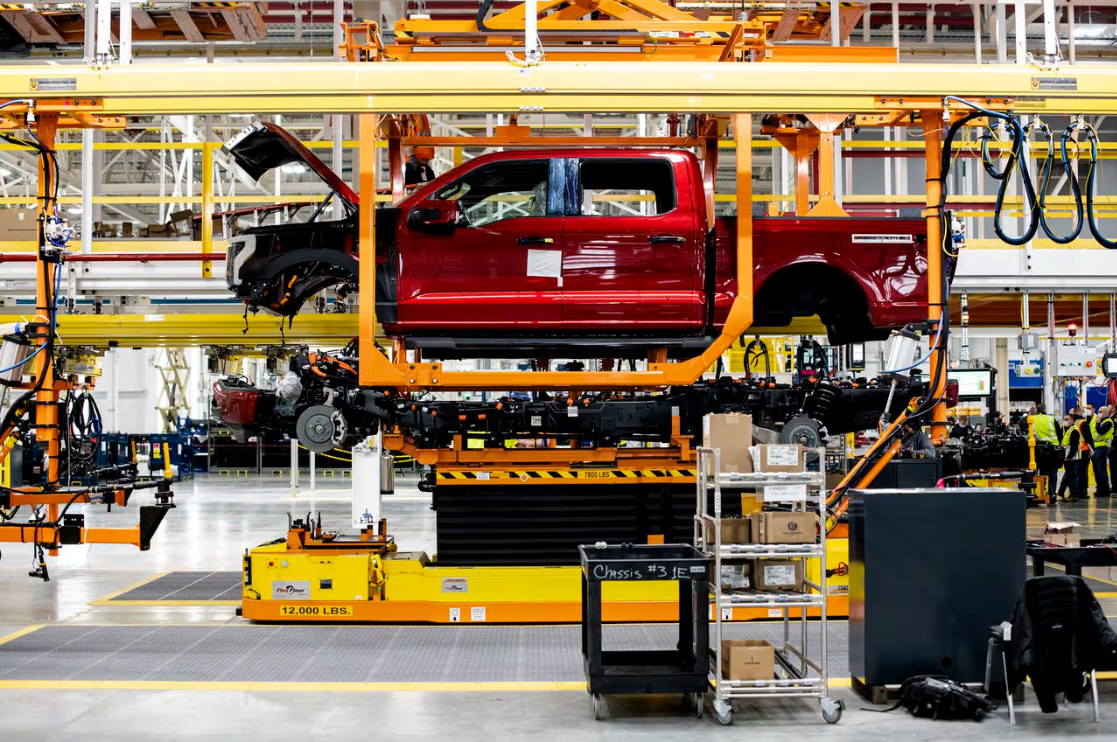拜登政府宣布旨在扩大电动汽车的规则

【中美创新时报2024年3月21日讯】(记者温友平编译)拜登政府周三(3月20日)发布了美国历史上最重要的气候法规之一,该法规旨在确保到 2032 年美国销售的大多数新乘用车和轻型卡车都是全电动或混合动力。《纽约时报》记者Coral Davenport 对此作了下述报道。
经过近三年的制定,美国环境保护局新的尾气污染限制将改变美国汽车市场。去年,经销商的电动汽车销量达到创纪录的 120 万辆,但仅占美国汽车总销量的 7.6%,远低于新规定规定的 56% 的目标。另外 16% 的新车销量将是混合动力汽车。
汽车和其他交通方式共同构成了美国碳排放的最大单一来源,这些污染正在推动气候变化,并导致 2023 年成为有记录以来最热的一年。电动汽车是乔·拜登总统应对全球变暖战略的核心,该战略呼吁到本十年末将国家排放量减少一半。但电动汽车也已变得政治化,并成为 2024 年总统竞选的一个热点。
拜登在一份声明中表示:“三年前,我设定了一个雄心勃勃的目标:2030 年售出的所有新车和卡车中的一半将实现零排放。” “我们共同取得了历史性进展。 全国数百家新扩建工厂。数千亿的私人投资和数千个高薪工会工作岗位。我们将实现 2030 年的目标,并在未来几年继续前进。”
随着时间的推移,该规则越来越多地限制排气管所允许的污染量,因此,到 2032 年,美国销售的一半以上的新车很可能是零排放汽车,以便汽车制造商满足标准。

据 EPA 称,这将在未来 30 年内避免超过 70 亿吨二氧化碳排放。 这相当于消除美国一年产生的所有温室气体,而美国历来是向大气中排放二氧化碳最多的国家。 该机构表示,该法规每年将为社会带来近 1000 亿美元的净效益,其中包括因空气质量改善而带来的 130 亿美元的年度公共卫生效益。
据 EPA 估计,这些标准还将为美国驾驶员在车辆的整个使用寿命期间节省约 6,000 美元的燃油和维护费用。
向电动汽车的过渡需要制造业、基础设施、技术、劳动力、全球贸易和消费者习惯的巨大改变。
而且它已经变得充满政治色彩。前总统唐纳德·特朗普正在竞选 11 月从拜登手中夺回白宫的竞选活动,他一直试图将电动汽车武器化,在竞选集会上重复有关电动汽车性能和承受能力的虚假言论,并使用越来越激烈的言辞。最近,他警告说,有关电动汽车的言论可能会引发“血腥洗礼”。
游说组织美国燃料和石化制造商组织在宾夕法尼亚州、密歇根州、威斯康星州、内华达州和亚利桑那州,以及俄亥俄州、蒙大拿州和华盛顿特区的市场。
EPA 法规不是禁令。它没有强制销售电动汽车,燃气动力汽车和卡车仍然可以销售。 相反,它要求汽车制造商在整个产品线中满足严格的新平均排放限制。由制造商决定如何遵守。
根据《清洁空气法》,该机构可以限制每年销售的汽车总数所产生的污染。美国环保署官员表示,汽车制造商可以通过销售传统汽油汽车、混合动力汽车、电动汽车或其他类型的汽车(例如氢动力汽车)来遵守排放上限。 新规定不适用于二手汽车或轻型卡车的销售,将于 2027 年车型年份开始生效。
超过新限制的汽车公司可能会面临巨额处罚。
汽车创新联盟主席约翰·博泽拉 (John Bozzella) 在一份声明中表示,新规则是“一个延伸目标”,但提供了一定的灵活性。该联盟代表了 42 家汽车公司,几乎所有在美国销售的新车均由这些公司生产。 “未来是电动的,”他说。不过,他说,该规则“考虑到了选择对驾驶员的重要性,并保留了他们选择适合自己的车辆的能力”。
但预计该规则将立即面临化石燃料公司和共和党总检察长联盟的法律挑战,这些投诉可能会上诉至最高法院。
“他们可能希望我们所有人都开电动汽车,或者根本不开汽车,但最终这不是他们的决定,”参与其中的主要石油和天然气生产州路易斯安那州总检察长伊丽莎白·穆里尔 (Elizabeth Murrill) 表示 在一系列挑战拜登环保局的诉讼中。“他们按照自己的愿景重塑社会的权力是有限的,法院已经意识到这一点。”
汽车排放规定是拜登政府四项主要气候法规中影响最大的一项,其中包括限制发电厂、卡车以及油气井甲烷泄漏的排放。该规则是在美国历史上最大的气候法《2022 年通货膨胀削减法案》的基础上制定的,该法案提供至少 3700 亿美元的联邦激励措施来支持清洁能源,包括向电动汽车购买者提供税收抵免。
这些政策旨在帮助美国实现拜登的目标,即到 2030 年将美国温室气体排放量减少一半,到 2050 年消除温室气体排放量。气候科学家表示,如果世界要避免最致命和代价高昂的气候影响,所有主要经济体都必须这样做 改变。
“这些标准构成了我们所认为的拜登政府历史性的气候大满贯,”自然资源保护委员会行动基金主席马尼什·巴普纳说,该基金是一个旨在推进环境事业的政治行动委员会。
巴普纳的团队计算出,这四项法规与《减少通货膨胀法案》相结合,到 2030 年将使美国的温室气体排放量减少 42%,从而使该国基本实现拜登的 2030 年目标。
特朗普承诺,如果他重返白宫,他将删除这些气候项目。
拜登政府正在加紧敲定气候法规,以保护他们在两极分化的政治气候下免受迫在眉睫的威胁:根据法规,只要该规则在总统任期结束前60多个立法日公布,就无法消除 在国会以简单多数票通过。
在制定最终的尾气排放法规时,政府放松了对汽车制造商及其最大工会汽车工人联合会的一些让步。
尽管主要汽车公司一直在大力投资制造和营销全电动汽车,但他们抱怨一年前最初提出的规则所要求的变革步伐太快。
加入工会的汽车工人对白宫也表达了同样的看法,他们担心电动汽车的快速过渡,因为电动汽车的零部件较少,需要更少的工人来生产,而且许多新的电动汽车工厂正在不支持工会的州建造。
美国汽车工人联合会在周三的一份声明中表示,美国环保局“在制定更可行的排放规则方面已经取得了长足的进步”,该规则将保护制造汽油动力汽车的工人,同时为汽车制造商“实施全方位的汽车排放规则”开辟道路。减少排放的技术。”
拜登既需要汽车行业的合作,也需要 2020 年支持他的汽车工人工会的政治支持。汽车行业在密歇根州雇佣了数千名选民,这个摇摆州可能决定谁将在 11 月入主白宫。
作为回应,EPA 的最终规则放宽了汽车制造商在最初几年必须遵守该规则的速度,直到 2030 年之后才大幅加快。
这降低了汽车制造商在 2030 年之前必须销售的电动汽车数量,也意味着排放量下降的速度将会更慢。气候科学家警告说,排放量必须迅速大幅下降,才能避免气候变化带来的最具灾难性的影响。
生物多样性中心安全气候运输运动主任丹·贝克尔 (Dan Becker) 表示:“EPA 迫于大型汽车、大型石油公司和汽车经销商的压力,在该计划中留下了足以让福特 F-150 通行的漏洞。” 他说,汽油动力汽车将“在这十年的大部分时间里占据主导地位,直到本世纪中叶,它的消耗和污染仍然很大”。
EPA 官员表示,最终规则仍将在 30 年内减少相同数量的排放量。
美国环保署署长迈克尔·S·里根 (Michael S. Regan) 在接受记者电话采访时被问及这种权衡时表示,这些变化旨在制定一项“更强有力、更持久”的政策,换句话说,一项不太可能被实施的政策。被未来的政府或法院撤销。“我们不会牺牲我们希望看到的环境收益,”他说。
即使美国环保署的新限制能够克服法律挑战,从内燃机的过渡也取决于许多其他因素。
缺乏电动汽车公共充电站仍然是一个问题。尽管去年安装了超过 172,000 个充电器,但分析师预测,到 2030 年,美国将需要超过 200 万个充电器,以支持 EPA 法规所设想的电动汽车增长。
与此同时,电动汽车销量的增长正在放缓,尽管新法规要求电动汽车销量在短短八年内增长近十倍。 新款电动汽车的购买者有资格获得高达 7,500 美元的联邦税收抵免,但目前只有 18 款车型有资格获得全额抵免,低于去年的大约 20 款。其中一款符合条件的车型是福特 F-150 Lightning 纯电动皮卡,其等候名单一度达到 20 万辆,去年销量为 2.4 万辆,远低于福特预计的 15 万辆。
“最终,这将取决于消费者,”标准普尔全球移动汽车智能服务分析师斯蒂芬妮·布林利 (Stephanie Brinley) 表示。 “他们被要求改变驾驶方式、购买方式以及与车辆互动的方式。 而且你不能把他们推得比他们要走的速度更快。”
本文最初发表于《纽约时报》。
题图:2022 年 1 月 25 日,密歇根州迪尔伯恩福特工厂生产线上的一辆电池驱动的 F-150 Lightning 卡车。BRITTANY GREESON/NYT
附原英文报道:
Biden administration announces rule aimed at expanding electric vehicles
By Coral Davenport New York Times,Updated March 21, 2024
The Biden administration on Wednesday issued one of the most significant climate regulations in the nation’s history, a rule designed to ensure that the majority of new passenger cars and light trucks sold in the United States are all-electric or hybrids by 2032.
Nearly three years in the making, the new tailpipe pollution limits from the Environmental Protection Agency would transform the US automobile market. A record 1.2 million electric vehicles rolled off dealers’ lots last year, but they made up just 7.6 percent of total US car sales, far from the 56 percent target under the new regulation. An additional 16 percent of new cars sold would be hybrids.
Cars and other forms of transportation are, together, the largest single source of carbon emissions generated by the United States, pollution that is driving climate change and that helped to make 2023 the hottest year in recorded history. Electric vehicles are central to President Joe Biden’s strategy to confront global warming, which calls for cutting the nation’s emissions in half by the end of this decade. But EVs have also become politicized and are a flashpoint in the 2024 presidential campaign.
“Three years ago, I set an ambitious target: that half of all new cars and trucks sold in 2030 would be zero-emission,” said Biden in a statement. “Together, we’ve made historic progress. Hundreds of new expanded factories across the country. Hundreds of billions in private investment and thousands of good-paying union jobs. And we’ll meet my goal for 2030 and race forward in the years ahead.”
The rule increasingly limits the amount of pollution allowed from tailpipes over time so that, by 2032, more than half the new cars sold in the United States would most likely be zero-emissions vehicles in order for carmakers to meet the standards.
That would avoid more than 7 billion tons of carbon dioxide emissions over the next 30 years, according to the EPA. That’s the equivalent of removing a year’s worth of all the greenhouse gases generated by the United States, the country that has historically pumped the most carbon dioxide into the atmosphere. The regulation would provide nearly $100 billion in annual net benefits to society, according to the agency, including $13 billion of annual public health benefits thanks to improved air quality.
The standards would also save the average American driver about $6,000 in reduced fuel and maintenance over the life of a vehicle, the EPA estimated.
The transition to electric vehicles would require enormous changes in manufacturing, infrastructure, technology, labor, global trade and consumer habits.
And it has become politically fraught. Former President Donald Trump, who is campaigning to retake the White House from Biden in November, has sought to weaponize electric vehicles, repeating false claims during campaign rallies about their performance and affordability and using increasingly heated rhetoric. Most recently, he warned of a “blood bath” in the middle of remarks about electric vehicles.
The American Fuel & Petrochemical Manufacturers, a lobbying organization, has started what it says is a “seven figure” campaign of advertising, phone calls and text messages against what it falsely calls “Biden’s EPA car ban” in the swing states Pennsylvania, Michigan, Wisconsin, Nevada and Arizona, as well as in Ohio, Montana and the Washington, D.C., market.
The EPA regulation is not a ban. It does not mandate the sales of electric vehicles, and gas-powered cars and trucks could still be sold. Rather, it requires carmakers to meet tough new average emissions limits across their entire product line. It’s up to the manufacturers to decide how to comply.
Under the Clean Air Act, the agency can limit the pollution generated by the total number of cars sold each year. EPA officials said automakers could comply with the emissions caps by selling a mix of conventional gasoline-burning cars, hybrids, electric vehicles or other types of vehicles, such as cars powered by hydrogen. The new regulation, which would not apply to sales of used automobiles or light trucks, would take effect starting with model year 2027.
Car companies that exceed the new restrictions could face substantial penalties.
John Bozzella, president of the Alliance for Automotive Innovation, which represents 42 car companies that produce nearly all the new vehicles sold in the United States, said in a statement that the new rule was “a stretch goal” but one that offered some flexibility. “The future is electric,” he said. Still, the rule is “mindful of the importance of choice to drivers and preserve their ability to choose the vehicle that’s right for them,” he said.
But the rule is expected to face an immediate legal challenge by a coalition of fossil fuel companies and Republican attorneys general, complaints that are likely to wind their way to the Supreme Court.
“They may wish for us all to drive EVs or no cars at all, but at the end of the day that’s not their decision,” said Elizabeth Murrill, the attorney general of Louisiana, a major oil and gas producing state that has been involved in a series of lawsuits challenging the Biden EPA. “There is a limit to their authority to remake society in their own vision and the court has realized that.”
The auto emissions rule is the most impactful of four major climate regulations from the Biden administration, including restrictions on emissions from power plants, trucks and methane leaks from oil and gas wells. The rule comes on top of the 2022 Inflation Reduction Act, the biggest climate law in the nation’s history, which is providing at least $370 billion in federal incentives to support clean energy, including tax credits to buyers of electric vehicles.
The policies are intended to help the country meet Biden’s target of cutting US greenhouse emissions in half by 2030 and eliminating them by 2050. Climate scientists say all major economies must do the same if the world is to avert the most deadly and costly effects of climate change.
“These standards form what we see as a historic climate grand slam for the Biden administration,” said Manish Bapna, president of the Natural Resources Defense Council Action Fund, a political action committee that aims to advance environmental causes.
Bapna’s group has calculated that the four regulations, combined with the Inflation Reduction Act, would reduce the nation’s greenhouse emissions 42 percent by 2030, getting the country most of the way to Biden’s 2030 target.
Trump has promised to delete those climate programs should he return to the White House.
The Biden administration is racing to finalize climate regulations to protect them from one looming threat in a polarized political climate: According to statute, as long as the rule is published more than 60 legislative days before the end of the presidential term, it cannot be eliminated by a simple majority vote in Congress.
In writing the final tailpipe regulation, the administration relaxed some elements in a concession to car manufacturers and their biggest union, the United Auto Workers.
Even though major auto companies have been investing substantially in building and marketing all-electric vehicles, they have complained that the pace of change required under the rule as originally proposed a year ago was too rapid.
Unionized autoworkers, who fear a rapid transition to electric vehicles because they have fewer parts that require fewer workers to produce, and because many new EV plants are being built in states that don’t support union labor, told the White House the same thing.
In a statement Wednesday, the United Auto Workers said the EPA had “come a long way to create a more feasible emissions rule” that would protect workers who build gas-powered cars while creating a path for carmakers to “implement the full range of automotive technologies to reduce emissions.”
Biden needs both cooperation from the auto industry and political support from the unionized autoworkers who backed him in 2020. The auto industry employs thousands of voters in Michigan, a swing state that could determine who will win the White House in November.
In response, the final EPA rule relaxed the pace at which automakers must comply with the rule in its early years, ramping it up sharply only after 2030.
That lowers the number of EVs that automakers must sell before 2030, and it also means that emissions will go down more slowly. Climate scientists have warned that emissions must drop sharply and quickly in order to stave off the most catastrophic impacts of climate change.
“EPA caved to pressure from Big Auto, Big Oil and car dealers and riddled the plan with loopholes big enough to drive a Ford F-150 through,” said Dan Becker, director of the Center for Biological Diversity’s Safe Climate Transport Campaign. Gas-powered cars would “dominate sales through much of this decade, guzzling and polluting into the middle of the century,” he said.
EPA officials said the final rule would still cut the same amount of emissions over 30 years.
Asked about that trade-off in a telephone call with reporters, Michael S. Regan, the administrator of the EPA, said the changes were designed to lead to a “stronger, more durable” policy, in other words, one less likely to be rolled back by a future administration or the courts. “We’re not sacrificing the environmental gains we want to see,” he said.
Even if the new EPA limits survive legal challenges, a transition away from the internal combustion engine depends on a number of other factors.
A lack of public charging stations for electric vehicles remains a problem. While more than 172,000 were installed last year, analysts project that the nation will need more than 2 million chargers by 2030 to support the growth in electric vehicles envisioned by the EPA regulation.
At the same time, growth in sales of electric vehicles is slowing, even as the new regulations would require a nearly tenfold increase in such sales within just eight years. Buyers of new electric vehicles are eligible for up to $7,500 in federal tax credits, but only 18 models are currently eligible for that full credit, down from about two dozen last year. One of those eligible models, the Ford F-150 Lightning, an all-electric pickup truck that once had a waiting list of 200,000, last year saw sales of 24,000, far short of the 150,000 sales projected by Ford.
“At the end of the day, this is going to be up to consumers,” said Stephanie Brinley, an analyst for the Auto Intelligence service at S&P Global Mobility. “They’re being asked to change their patterns of what they drive, what they buy, how they interact with their vehicles. And you can’t push them faster than they are going to go.”
This article originally appeared in The New York Times.

